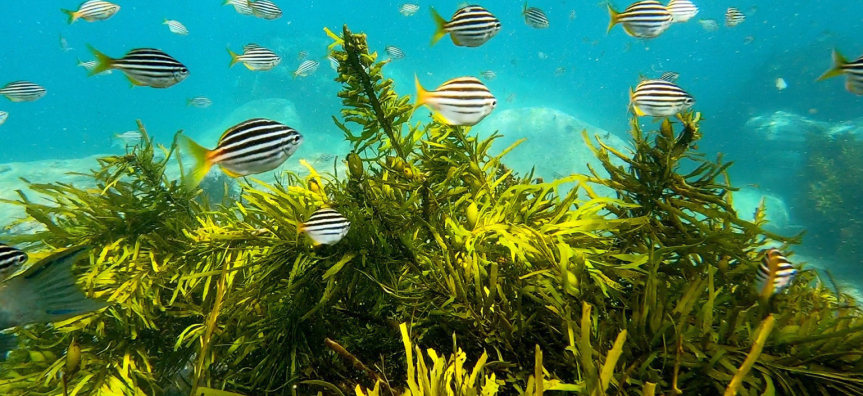
Life Below Water – Cabbage Tree Bay Aquatic Reserve
Crayweed
Interview with Maddy Langley, Marine Ecologist. Maddy describes why crayweed is important for Cabbage Tree Bay. The video contains overlay shots of crayweed mats with Craybies growing and Maddy observing their behaviour underwater in the bay.
Video text transcript
(Maddy is sitting on the rocks overlooking Cabbage Tree Bay. She describes why crayweed is important for Cabbage Tree Bay. The video contains overlay shots of crayweed mats with Craybies growing and Maddy observing their behaviour underwater in the bay.)
Maddy Langley: As you are swimming or snorkelling through Cabbage Tree Bay, you might come across these strange looking mats on the rocks that have pieces of seaweed attached to them. What you’ve actually come across is part of our crayweed restoration project.
Crayweed used to grow all along the Sydney coastline, but it disappeared in the 1970s and 1980s due to poor water quality at that time. Now the good news is that we have vastly improved our water quality off Sydney a lot over the past few decades, but crayweed hasn’t returned on its own and hasn’t returned here to Cabbage Tree Bay.
We first planted crayweed here in April of 2019 and a few months later we started to see little, tiny crayweed babies or ‘craybies’ as we call them started to appear around our restoration mats and over the next or two, we will watch those little craybies grow into crayweed adults and they will then be able to release reproductive material and be the start of a self-sustaining crayweed forest.
First we saw about 50, then we saw 100, and now every time we visit we see more and more craybies popping up. Crayweed is quite an interesting type of seaweed because it has male and female individuals.
If you pluck a blade of crayweed and hold it up to the light, you can actually see the vesicles containing that reproductive material and depending on the shape of those vesicles, you can determine whether its male or female.
Crayweed is an important habitat forming species that forms underwater forests. We find that abalone and crayfish like to live amongst the crayweed, which is actually how crayweed got its name.
Cabbage Tree Bay is now part of what scientists are now calling the Great Southern Reef. So, when we think of reefs, we often think of tropical, coral species, but seaweed forms reefs as well and by bringing crayweed back into the bay, we are further enhancing this biodiversity by providing another type of habitat.
